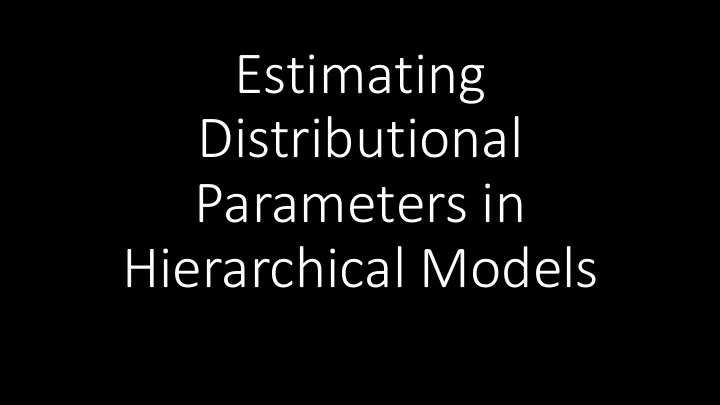

Estimating Distributional Parameters in Hierarchical Models
Introduction: Variability in Hierarchical Models
Linear Models 𝑧 𝑗𝑘 = 𝛾 0 + 𝛾 1 𝑌 𝑗𝑘 + 𝑓 𝑗𝑘 𝑓 𝑗𝑘 ∼ 𝑂(0, σ 2 ) • Modelling central tendency • Response ( 𝑧 𝑗𝑘 ) is a sum of intercept ( 𝛾 0 ), slopes ( 𝛾 1 , 𝛾 2 , … ), and error ( 𝑓 𝑗𝑘 ) • Error is assumed to be normally distributed around zero
Linear Models lm(y ~ pred) • Modelling central tendency • Response (y) is a sum of intercept (implicit), slopes (pred), and error (implicit) • Error is assumed to be normally distributed around zero
Linear Mixed Effects Models 𝑧 𝑗𝑘 = 𝛾 0 + μ 0𝑗 + (𝛾 1 + μ 1𝑗 )𝑌 𝑗𝑘 + 𝑓 𝑗𝑘 μ 0𝑗 ∼ 𝑂(0, σ 2 ) μ 1𝑗 ∼ 𝑂(0, σ 2 ) 𝑓 𝑗𝑘 ∼ 𝑂(0, σ 2 ) • Modelling central tendency • Response ( 𝑧 𝑗𝑘 ) is a sum of intercept ( 𝛾 0 ), slopes ( 𝛾 1 , 𝛾 2 , … ), random unit intercepts ( μ 0𝑗 ), random unit slopes ( μ 1𝑗 ), and error ( 𝑓 𝑗𝑘 ) • Error, random intercepts, and random slopes are assumed to be normally distributed around zero
Linear Mixed Effects Models lmer(y ~ pred + (pred | rand_unit)) • Modelling central tendency • Response (y) is a sum of intercept (implicit), slopes (pred), random unit intercepts (pred || rand_unit), random unit slopes (pred | rand_unit), and error (implicit) • Error, random intercepts, and random slopes are assumed to be normally distributed around zero
Example Non-Gaussian Data: RT • 2AFC: does the word match the picture? • Congruency (2) x Predictability (12% – 100%) • 35 Subjects, 200 trials bandage + sardine
Gamma Family GLMM m_glmer <- glmer( rt ~ cong * pred + (cong * pred | subj) + (cong | image) + (1 | word), family = Gamma(identity), control = glmerControl( optimizer = “ bobyqa ”, optCtrl = list(maxfun = 2e5) ) )
GLMM Results
GLMM Results – Random Effects summary(m_glmer)
GLMM Results – Random Effects ranef(m_glmer)
GLMM Results – Random Effects m_glmer %>% ranef() %>% as.data.frame()
GLMM Results – Random Effects ranef(m_glmer) %>% as_tibble() %>% filter(grpvar == “subj") %>% mutate(grp = fct_reorder2(grp, term, condval)) %>% ggplot(aes( x = grp, y = condval, ymin = condval - condsd, ymax = condval + condsd )) + geom_pointrange(size=0.25) + facet_wrap(vars(term), scales="free", nrow=2)
GLMM Results – Random Effects – Subject
GLMM Results – Random Effects – Image
GLMM Results – Random Effects – Word
Estimating Distributional Parameters in Hierarchical Models
What if Meaningful Effects on Variance? • All glm variants model single parameters (i.e. central tendency) • What if your effect looks like this?
What if Meaningful Effects on Variance? • Mu is higher F(1, 1998) = 3237, p <.001 • Sigma is higher Levene’s F(1, 1998) = 550, p <.001
Assumption-free Distribution Comparison • Within a single model? • Assumption free distribution comparison (e.g. Kolmogorov – Smirnov) could be one approach! • Overlapping index (Pastore & Calcagni, 2019) from 0 (no overlap) to 1 (identical distribution)
Assumption-free Distribution Comparison x <- rnorm(1000, 10, 1), y <- rnorm(1000, 10.5, 1.5)
Assumption-free Distribution Comparison
Overlap Index Mu * Sigma Parameter Space
Overlap Index Mu * Sigma Parameter Space
Overlap Index Mu * Sigma Parameter Space
Weirder Distribution Example
Weirder Distribution Example
Summary so far • Assumption- free approaches are flexible but don’t allow us to test/make any specific predictions • Equivalent of shrugging and saying “yeah idk probs something going on there” (though useful for very weird distributions) • Explicitly modelling multiple parameters of an assumed distribution can give us more meaningful info
Distributional Parameters in brms brm( bf( dv ~ Intercept + iv + (iv | rand_unit), sigma ~ Intercept + iv + (iv | rand_unit) ), control = list( adapt_delta = 0.999, max_treedepth = 12 ), sample_all_pars = TRUE )
Shifted Log-Normal Distribution
Shifted Log-Normal Distribution
Bayesian Shifted Log-Normal Mixed Effects Model with Distributional Parameters brms::bf( rt ~ Intercept + cong * pred + (cong * pred | subj) + (cong | image) + (1 | word), sigma ~ rt ~ Intercept + cong * pred + (cong * pred | subj) + (cong | image) + (1 | word), ndt ~ rt ~ Intercept + cong * pred + (cong * pred | subj) + (cong | image) + (1 | word) )
Bayesian Results – Random Effects ranef(m_bme) ID (e.g. subj_01, subj_02…) * value ( est, err, Q2.5, Q97.5) * fixed parameter
Caveats • Computationally intensive if using non- informative priors for complex hierarchical formulae • Have to avoid temptation to try over-infer about mechanisms unless using more cognitively informed models (e.g. drift diffusion)
Summary Hierarchical models with maximal structures for distributional parameters are a robust and appropriate way of looking at or accounting for subject/item/etc variability in fixed effects when you’re interested in more than central tendency. But , if you can assume no systematic differences in distributional parameters, GLMMs will suffice (and save you a lot of time and effort)!
Recommend
More recommend